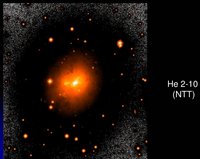

|
Galaxies are typically composed of stars, gas and dust arranged either into a flattened system (disk galaxies) or something which is roughly spherical (elliptical galaxies). Most of the light is to be found in the prominant, central regions of galaxies, but they can also be surrounded by a dim "halo" of light which can extend to very large distances from the center. What causes this light is at present something of a mystery.
Erik Zackrisson, of Tuorla Observatory, and colleagues N. Bergvall, G. Ostlin, G. Micheva and M. Leksell in Stockholm and Uppsala, have taken very long exposures of a range of galaxies, discovering that they are frequently embedded in dim halo light which is very red in colour --- that is to say, light at redder wavelengths strongly dominates over light at bluer wavelengths. Dim red halos around galaxies have been seen in many studies, including some done in space with the Hubble Space Telescope. What this light is caused by, and why it should be so red, is the question. One possibility is that it is emitted by very large numbers of low mass stars, which are known to be both very dim and very red from studies of such stars near the Sun. If the red halos are caused by dim stars, then there must be very many of them indeed to explain the feeble light they contribute to the red halos. Such stars would be almost as plentiful as stars of all other types, perhaps making them a significant contributor to the total mass of galaxies. The complication here is that the total mass of galaxies is quite a mystery anyway, due to the apparent presence of large amounts of dark matter, and perhaps red halos are providing us with an important clue (rather than a red herring!) on this aspect of galaxies as well. Zackrisson has studied some other ideas for what causes the red halo light, such as its being produced by stars with a high metal content (all elements other than Hydrogen and Helium are termed 'metals' by astronomers) or by nebulosity caused by hot gas clouds --- but neither of these explanations seem to work for all the galaxies surveyed. The study has been published in Astrophysical Journal, and a preprint is available here. |

Optical image of the blue compact galaxy He 2-10, taken with the ESO
New Technology Telescope. To demonstrate the size and projected shape
of its red halo, the latter has been subtracted away, leaving the dark
"shadow" surrounding the central galaxy." Image copyright N. Bergvall
(Uppsala Observatory). A larger version of this image is available
here.
|